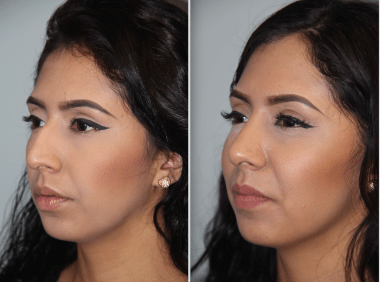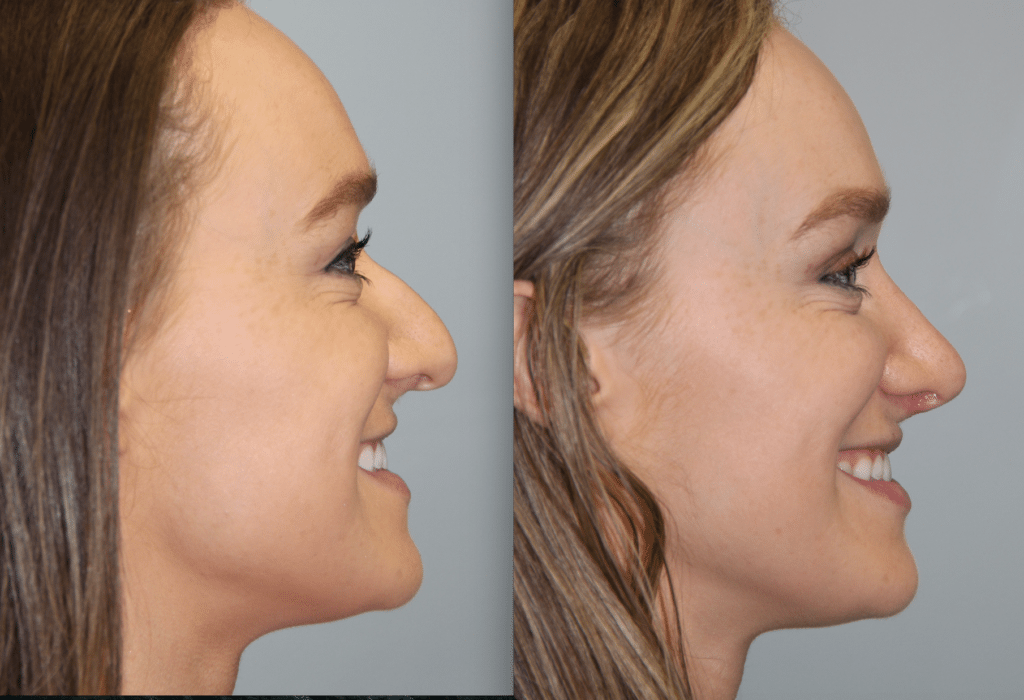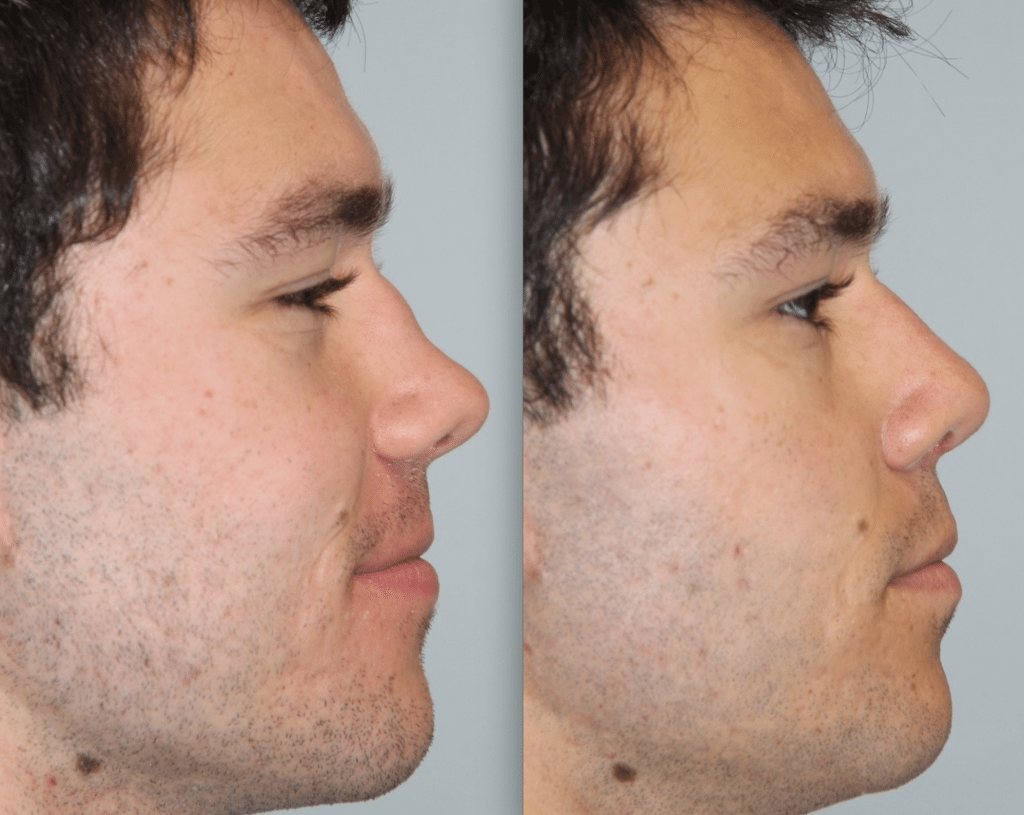Rhinoplasty
At Daines Plastic Surgery, double board-certified facial plastic surgeon Dr. Steven Daines offers rhinoplasty to his patients in the Newport Beach and Orange County areas. Dr. Daines understands that the nose is a focal point of the face and will work with accuracy and precision to deliver extraordinary results that leave you thrilled with your new nose. If you are dissatisfied with the appearance of your nose, let Dr. Daines and his expert staff of medical professionals help you feel confident in your own skin with a rhinoplasty procedure.
What Is Rhinoplasty?
Rhinoplasty, commonly referred to as a nose job, is a cosmetic procedure that focuses on improving nasal shape, size and symmetry according to a patient’s unique preferences. As a whole, rhinoplasty procedures can target:
- Nasal asymmetry
- Nasal humps
- A wide bridge
- Large or wide nostrils
- Hooked or droopy nasal tips
- Bulbous or poorly defined tips
- Damage from physical trauma
Every rhinoplasty procedure is different and tailored to the varying needs of each patient. Rhinoplasty can be performed as both an open and closed surgery, depending on the patient’s desired results and the recommendation of Dr. Daines. Open rhinoplasty involves a small incision placed between the nostrils, allowing Dr. Daines to pull back the nasal tissue and more efficiently address the underlying nasal structure. During closed rhinoplasty, also called endonasal rhinoplasty, all incisions are kept within the nostrils to eliminate visible scarring. Both procedural methods have their advantages and Dr. Daines will help you determine which is right for you during an in-person consultation.
Whereas rhinoplasty is usually intended to address cosmetic concerns, septoplasty, a separate type of nose surgery, can address functional concerns. Both rhinoplasty and septoplasty may be combined in one comprehensive procedure for the right patient. Let Dr. Daines know about all of your concerns, both functional and cosmetic, during your consultation. With your input, Dr. Daines can create a personalized treatment plan that addresses all of your needs.
Who Is a Good Candidate for Rhinoplasty?
Good candidates for rhinoplasty are patients with one or more concerns about the appearance of their nose who are healthy enough for surgery. Rhinoplasty does require some downtime, so patients should be prepared to set aside time from work and other responsibilities while they focus on healing. Patients interested in rhinoplasty should have realistic expectations about their results and understand that it will take several months for their final appearance to develop completely.
Rhinoplasty is highly customizable, allowing Dr. Daines to address a wide variety of cosmetic issues during the procedure. During your consultation, Daines will explain both open and closed rhinoplasty with you in detail. He may also discuss alarplasty, a nose surgery that focuses exclusively on changing the width or shape of the nostrils, if necessary. Patients interested only in improving their breathing by correcting a deviated septum may not need a formal rhinoplasty and could benefit from a septoplasty procedure alone. Exactly which rhinoplasty method you are a candidate for will depend on your anatomy and desired results.
Your Rhinoplasty Procedure
Dr. Daines will discuss the differences between open and closed rhinoplasty before your surgery, ensuring you know exactly what to expect on the day of your surgery. Open rhinoplasty is often the optimal and preferred choice for making anything more than minor alterations. When it comes to choosing the correct procedure, the method that produces the best results possible should always be given preference.
Open Rhinoplasty
Open rhinoplasty is performed under general anesthesia. Once you have been numbed and sedated, Dr. Daines will make a small incision across your columella, the thin piece of tissue bridging your nostrils. He will then gently pull the skin back to expose the underlying nasal structure, allowing him to operate with complete visibility for increased accuracy and precision. During the procedure, Dr. Daines may remove, add or rearrange small pieces of bone and cartilage to alter the shape of your internal nasal structure. If needed, cartilage grafts will primarily be taken from the nasal septum, although they may occasionally be sourced from an ear or a rib.
Open rhinoplasty takes longer than closed rhinoplasty, lasting between two and four hours on average. Once Dr. Daines has enhanced the underlying structure of your nose, he will suture the small incision to complete the procedure.
Closed Rhinoplasty
Closed rhinoplasty is commonly performed using general anesthesia, although local anesthesia may also be used if you require minimal alterations. All incisions are kept inside the nostrils, eliminating visible scars in exchange for limited visibility during the procedure. After making the internal incisions, Dr. Daines will remove or rearrange small pieces of cartilage and bone to achieve your desired results. Closed rhinoplasty is only intended for minor changes and may not be a viable option for all patients.
As a less invasive procedure, closed rhinoplasty can typically be completed in one to two hours.
Alarplasty
Alarplasty, sometimes referred to as alar base reduction or nostril surgery, focuses only on changing the width or shape of the nostrils. Alarplasty can sometimes be performed under local anesthesia. During the procedure, Dr. Daines will make incisions in the creases of your nostrils where they meet your cheeks. He will then remove a small wedge of nasal tissue from both sides to promote balance and symmetry. Once your desired shape has been achieved, Dr. Daines will stitch the incisions shut to complete the procedure.
Alarplasty is fairly quick and lasts only one hour on average. The procedure can also be combined with elements of rhinoplasty if you are interested in addressing other cosmetic concerns in addition to the shape of your nostrils.
Recovering from Your Surgery
Following your procedure, you are free to return home and begin resting. An external splint will be placed across your nose to provide support and protection for your new nose. A non-stick sponge will be left inside your nostrils overnight in lieu of traditional nasal packing. Any non-dissolvable sutures will be removed about one week after your surgery.
Because rhinoplasty varies greatly among patient to patient, every patient’s recovery will also vary. In general, open rhinoplasty tends to require a longer recovery than closed rhinoplasty. You should plan on taking at least a full week off from work and other normal activities. Most patients feel comfortable leaving home and going out in public after seven to 10 days, although a full recovery will take two weeks or longer. Exercise and other strenuous activities should be avoided for about three to four weeks, or until Dr. Daines advises it is safe to resume them. Contact sports can be continued once the new nose has fully healed, although patients will need to wear proper protection to avoid damaging their results.
Common side effects of the procedure include swelling, bruising, bleeding, numbness, congestion and discomfort. Any bleeding should stop within 24 hours. You will need to sleep with an elevated head for the first few nights of your recovery to minimize swelling and avoid direct pressure on your nose while resting. Most visible side effects will heal after two weeks, although swelling and congestion will take several months to subside completely.
Your Rhinoplasty Results
Following your rhinoplasty procedure, the new and improved shape of your nose will be visible. Swelling, bruising and the presence of nasal splints or bandages may affect your appearance, however. Most patients can start enjoying their results in about two to three weeks after the majority of the swelling has dissipated. Some small amounts of residual swelling will linger for several months, so expect your final results to be noticeable in about six to 12 months.
Any external incisions will heal in a matter of weeks. Once the incisions have closed, your scar will begin maturing. Surgery incisions can take 12 to 18 months to mature completely and will gradually fade to a thin white line that appears unnoticeable. Rest assured, Dr. Daines will take every step possible to minimize scarring and ensure your results match your expectations.
Dr. Daines will provide you with specific post-op instructions to help you care for your new nose and enjoy a comfortable and successful recovery. If you ever have any questions or concerns about your recovery, Dr. Daines and his staff are only a phone call away.
Choosing the Right Surgeon for Your Rhinoplasty
When it comes to facial plastic surgery, you deserve the best results possible. With double board certification in facial plastic and reconstructive surgery as well as otolaryngology (ENT surgery), Dr. Daines is qualified to deliver exceptional results. Dr. Daines understands the complex anatomy of the face and nose and has spent years performing rhinoplasty procedures on satisfied patients. He always emphasizes natural results and creates tailored approaches for each of his patients, helping you bring your unique vision to life while maintaining a natural appearance.
Experience the Exceptional at Daines Plastic Surgery
If you are unhappy with the size, shape or general appearance of your nose, schedule a consultation at Daines Plastic Surgery to learn if a rhinoplasty procedure is right for your needs. Patients throughout Orange County and Newport Beach have consistently turned to Dr. Daines’ expertise and enjoyed satisfying results that last a lifetime. Dr. Daines will take the time to sit down with you in a one-on-one consultation and answer all of your questions, including if you are a candidate for rhinoplasty, how much a nose job costs and what sort of results you can expect.
To schedule your consultation with Dr. Daines in Newport Beach, Orange County, call us today at 949-209-1622.
Rhinoplasty FAQs
Are There Any Risks Associated With Rhinoplasty?
As with any surgical procedure, there are potential risks and side effects for rhinoplasty. More common side effects include bleeding, swelling and bruising after your surgery, but these usually subside if given the proper healing time. Less common risks include nasal septal perforation, a hole in the nasal septum (rare), difficulty breathing, poor wound healing and scarring and dissatisfaction with the outcome of your rhinoplasty. Dr. Daines will thoroughly review possible side effects and risks with you during an initial consultation and provide you with post-surgery instructions to ensure you heal properly.
Dr. Daines is an expert in rhinoplasty surgery, so serious adverse events are unlikely. If you find that your results fall short of your expectations, it’s possible to have a revision rhinoplasty. Revision rhinoplasty is essentially the same as primarily rhinoplasty but involves correcting any cosmetic or functional concerns you have after the initial procedure. Patients are advised to wait at least one year before considering revision surgery to allow their initial rhinoplasty to heal fully.
What Additional Surgeries Complement Rhinoplasty?
Rhinoplasty is commonly paired with other facial procedures. In particular, augmenting or reshaping the chin with a chin implant can sometimes improve the perceived size of the nose and the overall harmony between facial features. Like the nose, the chin can become a source of concern if it is small or “weak” or contributes to a lack of jawline definition. Because these features are aesthetically linked, chin enhancement is commonly combined with rhinoplasty to balance facial proportions. Chin augmentation may also help minimize the surgical changes that need to be made in rhinoplasty to achieve an excellent result.
If you’re interested in any additional procedures, Dr. Daines can discuss your options in more detail. He may be able to perform them the same day as your rhinoplasty, so you can walk out of surgery with a whole new look and outlook on life.
How Do You Reduce Swelling of the Nose After Rhinoplasty?
You must follow post-surgery care instructions to reduce swelling and bruising after your rhinoplasty. If you have any questions or concerns regarding your healing process, don’t hesitate to give us a call. You should avoid blood-thinning medications and certain supplements before your surgery and during the recovery process. Medications, including ibuprofen and aspirin, run the risk of exacerbating bleeding, as do certain supplements. We’ll ask if you’re taking any of these before the procedure.
Specific steps you can take to reduce swelling and bruising include applying ice packs and keeping your head elevated. Ice reduces swelling, but only if used within the first few days after surgery. Keeping your head elevated will help, too, as it’ll promote greater blood circulation throughout your body. Often, rhinoplasty patients spend the first week or two after surgery sleeping in a recliner to elevate their head.
Most importantly… be patient! Giving your body the proper amount of time to heal is essential.
Is There a Nonsurgical Option for Rhinoplasty?
Absolutely! While rhinoplasty is an extremely popular procedure, some patients may feel wary about having surgery. Nonsurgical “liquid” rhinoplasty is an increasingly popular alternative that is less invasive than surgery and has little to no downtime. The procedure typically involves injecting your nose with a gel filler through an ultra-fine needle or cannula to add more volume to certain areas of the nose and create enhanced symmetry. The filler is often composed of hyaluronic acid, a substance that is naturally produced by your body to help maintain skin firmness and hydration. Nonsurgical rhinoplasty can be performed in as little as 15 minutes. Keep in mind, results for this procedure aren’t permanent. Results typically last for six months to one year, but follow-up treatments can be performed to maintain lasting results.
If the thought of surgery gives you anxiety and is preventing you from having the rhinoplasty you want, feel free to inquire about nonsurgical rhinoplasty with Dr. Daines.
What Are the Other Benefits of Rhinoplasty?
While rhinoplasty is primarily known for its cosmetic benefits, it comes with other potential benefits. If you’re unsatisfied with your nose, enhancing its shape and making it more consistent with to your other facial features can significantly improve your self-confidence and your comfort in social situations.
Other potential benefits may include improved breathing and reduced snoring. Rhinoplasty can improve blocked nasal passages, allowing for better airflow through your nose, less congestion, headaches and more. The treatment is also often performed on those suffering from sleep apnea, allowing for improved tolerance of CPAP devices. This version of nose surgery may be referred to as septoplasty.
What’s the Difference Between Rhinoplasty and Septoplasty?
Rhinoplasty is a cosmetic procedure that changes the appearance of the nose, while septoplasty is a functional procedure meant to improve breathing through the nasal passages. Septoplasty is performed primarily for medical reasons and involves straightening the nose’s wall that divides the left and right nasal passages. However, rhinoplasty may also successfully correct breathing issues if they arise due to the nose’s shape. Often, septoplasty and rhinoplasty are combined to boost aesthetics while improving nasal function and health.
*Board Certified Facial Plastic Surgeon Dr. Steven M Daines has written information about Rhinoplasty that has been carefully reviewed. If you have any questions, feel free to contact us using our form below.

The results were amazing! Not only did he straighten my nose, I can now breathe better, sleep better and have less allergies! On top of being extremely trustworthy, Dr. Daines and his staff are all very friendly. They each made an effort to get to know me and made sure I felt welcomed every time I walked in the door. I never thought I would say that I enjoyed a Doctor's visit, but I truly did. -Victoria B





